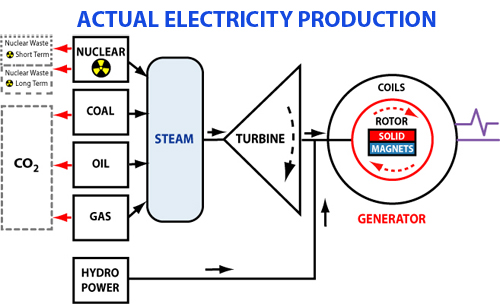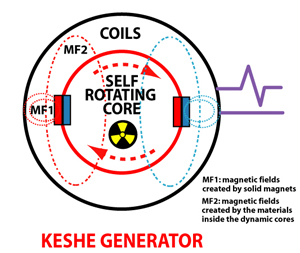This web page gives a new insight into the energy production capabilities of our systems. The concept of energy creation behind the development of this reactor is based on a new understanding of the laws of physics. Our technology results from applying this new understanding of the cooperation and interaction of the atomic structure of gases and matters upon each other. The principles of the behavior of gases and liquids in the environment have been studied and catalogued in detail over the past decades. This is an important factor in the development of any energy system that has to be portable and light, but at the same time flexible, powerful and functional to justify its use in any system, such as production of power, gravity or anti-gravity, shielding, medical purposes and so forth. For this system to meet these criteria it is important to use hydrogen as the primary catalyst. In 2005 Prof. Dr. ir. Marc Van Overmeire of the Univertity of Brussels (VUB), at the request of FLAG (Flanders Aerospace Group) looked into Mr Keshe’s energy concept and produced the following evaluation (download the pdf), concluding that the concepts behind this method of energy production are valid.
THE USE OF THE SYSTEM AS AN ENERGY SOURCE
This system is a fully integrated electro-nuclear-magnetic power generator. The system, in its core, creates the magnetic force field that man is used to as part of the magnetic fields of the Earth. The unit generates magnetic fields that can pass through tissues and atoms without affecting their characteristics.
Magnetic fields created by planets are called the Passive Magnetic Field Forces (PMF). These are what the whole universe uses to move moons, planets, stars and the galaxies. In utilizing these forces and the technology available through this system, electric energy can be created using hydrogen as fuel.
The creation of electric energy in this reactor is achieved through the simple process of hydrogen ionization. Elaborate systems have been developed to tap into this process during its interactions with other matters in the core of the reactor. The hydrogen supplied for this purpose is in a natural form that can be realized from water or the atmosphere through already established technologies.

Most present day systems for the production of electricity heat up water to create steam, which then drives a turbine that is connected to a magnet. This magnet rotates within a set of coils to produce the current. These systems produce a lot of pollution of various kinds.

The generation of electricity can be simplified by using the new Keshe generators which will contain only low, short term, nuclear sources. These generators will produce electricity over a long time, since the basic interactions are self-sustaining.

This is one type of Keshe generator. A spherical self-rotating reactor core spins inside a set(s) of coils. Additional magnets can be mounted on the reactor body. These generators can be installed where the electricity is needed.
HYDROGEN
Hydrogen gas at an atomic and molecular level has some fascinating properties. If these are used for the right purpose at the right time in the right combination, this element will provide most of what the systems need to facilitate all the above applications. It does not matter what form hydrogen takes when it is used in conjunction with other elements. Primary conditions can be created in the reactor that bring about all the desired effects. Hydrogen atoms by having one proton and one electron are the lightest element in the universe; it is one of the elements most commonly used for the creation of plasma.
To create plasma the electron needs to be separated from its nucleus by injecting enough energy into the atom to free the electron from the magnetic field of the nucleus. This process is known as the ionization of hydrogen atoms. Scientists have successfully achieved this for some time. If the electron that is excited can be made to give up its energy in an appropriate way, it can return to its original state. Then the production of current and heat is made simple.
These effects are created and used to produce energy and gravity in this reactor. In this process, electrons are released from their nuclei by a method that has been known to science for some time, where the reaction is achieved by a very simple method of magnetic environment injection using natural hydrogen atoms. This is a simple but effective method we have developed especially for application in this reactor. Then as other elements come into play, the true nature of hydrogen will reveal its potency in this system as a whole, as it has done in the universe. Where, how, how much and when these gases and matters are applied in the system, will create the effect that is required at the time.
So the system can be a power generator, then with a slight change in one of the parameters of one of the matters, it will become a gravity machine. Then by combining the two effects, one will have a system that not only generates energy, but holds gravity and creates anti-gravity too. With this system there is no need for the conventional present day fuels and methods to create energy and magnetism. In this system energy production is achieved simply by the normal creation of heat first, then gravity in the center of the core, with the help of the generation of magnetic fields through the correct method of circulation and cooling within the reactor. In the world of science it has always been considered that the core of a planet possesses magnetic fields that cause it to rotate. For the first time, through a new understanding of how gravitational forces are created in planets, M. T. Keshe has proven theoretically that the center of the Earth possesses two magnetic fields rather then one. Based on understanding the “double magnetic field” operation of the Earth's core, this gravitational system of Earth is replicated in the design of this new reactor, leading to the creation and control of gravity in its center.
In understanding the operation of this double magnetic field force, and incorporating it in the reactor that is being developed, new horizons are opened in the world of science and technology. For example, this can create enough heat to generate a super heated head of steam at the outer boundaries of the system that would be capable of running the present power station turbines if need be. It is even possible to create electric current directly from the reactor core. Since the system is fueled by hydrogen, there is no possibility of radiation leakage or radioactive waste problems due to other effects in this system. In present nuclear reactors, heat is collected using all sorts of moderators, cooling and blanketing in a concentrated way inside and outside the reactor’s core. Then the collected heat is fed through to run a (steam) turbine creating energy.
Through the specific design of our reactor all the heat distribution, transfer and circulation takes place internally, without the need to remove heat from the outside of the reactor in a concentrated way as has been done in the past. This has been achieved through understanding the natural method of heat dissipation that takes place in planets. The concept behind this technology was prompted by the simple fact that in the universe planets do not have cooling towers or exhaust pipes. Efforts were made to look at the real method of energy creation in the planets that have internal heating systems but are cool enough for people to walk on their surface, as with Earth. In a simple but effective way, this has been achieved in the core of this reactor, where heat is dissipated so that it will never reach the outer boundary of the reactor.
The advantage with this system is that when heat is redistributed in a slightly simpler way, and not in a concentrated method as in the present thermal nuclear reactors, totally different properties can be obtained from the reactor with the same fuel. The properties created in this system are what the whole universe uses to heat and move planets, stars and galaxies. This system uses technology that can and will lead to fusion, semi-fusion and fission if required. All this is achieved by using a reactor that has in its core no valves or screws, and as in the center of planets, requires a very small amount of hydrogen.
Recommended articles
Your Excellency President Donald J Trump Following your announcement of last week that you would meet anywhere and anytime, without any preconditions, the nation of Iran would like to invite you
...

